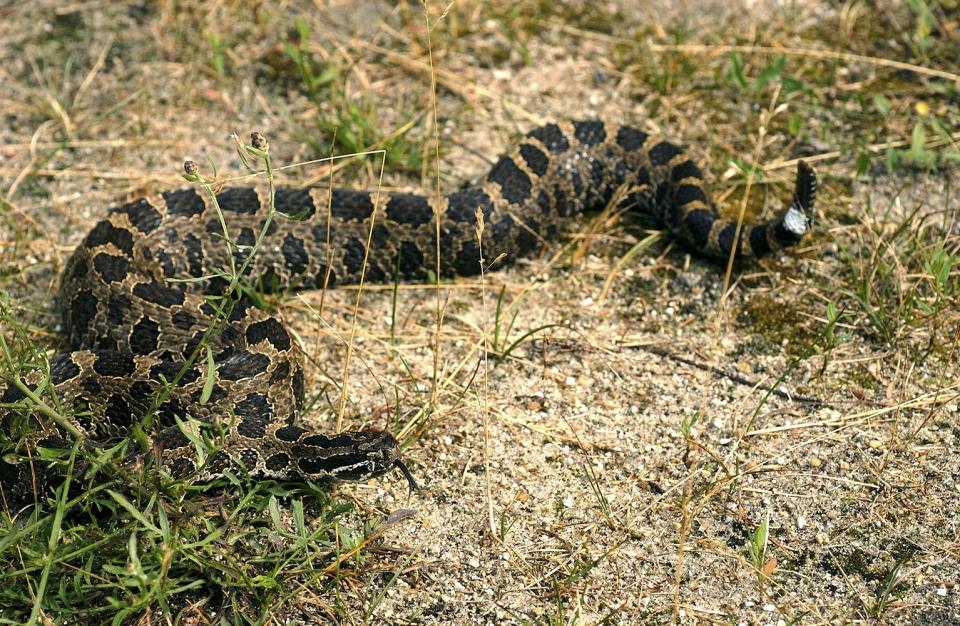Rare, endangered eastern massasauga rattlesnake found in Ohio. Here's what to know
A rare and endangered rattlesnake has been seen in Ohio.
An eastern massasauga rattlesnake was caught during the Ohio Division of Wildlife's annual snake survey last month by Huron County Wildlife Officer Matthew D. Smith, the Ohio Department of Natural Resources stated in a Facebook post.
Last month, our Ohio Division of Wildlife staff, researchers and volunteers participated in an annual snake survey....
Posted by Ohio Department of Natural Resources on Monday, June 3, 2024
Here's what to know about the snake and its place in the state.
All about the eastern massasauga rattlesnake in Ohio
One of three venomous snakes native to Ohio, the eastern massasauga is rare in Ohio and only found in a few select locations throughout the state, Kristin Stanford, wildlife diversity coordinator with the Ohio Division of Wildlife, said in an email Wednesday. It's very unlikely someone would come across one in the wild.
The snake has been historically recorded in 30 Ohio counties, but only seen in nine since 1976, according to the Reptiles of Ohio Field Guide produced by the Ohio Division of Wildlife.
Also known as the "swamp rattler" and "black snapper," the snake is considered "very sluggish," according to the Ohio Field Guide, and rarely bites unless "thoroughly provoked." Its bite, while containing a highly toxic venom, is rarely fatal to a healthy adult, because a typical bite doesn't deliver enough venom to be lethal.
The snake is listed as threatened under the Endangered Species Act in 2016, according to the U.S. Fish and Wildlife Service, "due to significant reductions in populations, primarily due to habitat loss."
Protecting Ohio's snakes: Rattlesnake found in Ohio proposed for threatened species list
Where was the massasauga rattlesnake found?
Stanford said ODNR typically does not release the location where individual snakes are found. In this case, however, she said it's "commonly known" that there is a population of these snakes at Killdeer Plains Wildlife area, south of the city of Upper Sandusky and about 65 miles north-northwest of Columbus. These snakes are well-studied by researchers, she said, and are the focus of an annual population survey to assess the species' health.
The snake found last month was measured to determine its growth and released, Stanford said. Killdeer Plains is one of several study sites where the snake population is surveyed for a variety of reasons.

How to identify the eastern massasauga rattlesnake
The snake is small -- less than 34 inches, according to the Ohio State University Massasauga Research project. The Ohio Field Guide calls the snake "stout" and puts its length between 18 and 24 inches.
The typical massasauga rattlesnake has a base color of gray, tan, yellow or brown, according to Ohio State. The top of the body is covered in brown blotches that run the length of the snake. Its belly is black with the occasional white or yellow mark.
Its head often has a narrow, looping white band surrounding a thicker dark-brown band. In Ohio, some of the snakes are all black.
What is the eastern massasauga rattlesnake's range and habitat?
The massasauga is found in the northern Midwest United States as well as Ontario, Canada, according to U.S. Fish and Wildlife.
The majority of its population is found in Michigan, according to U.S. Fish and Wildlife's interactive map. However, New York, Pennsylvania, Ohio, Indiana, Illinois, Wisconsin and Iowa still have "robust populations," according to the Fish and Wildlife, but those populations grow sparse and isolated toward the edge of the snake's range.
Eastern massasaugas can be found in shallow wetlands and the surrounding upland areas, according to Fish and Wildlife. According to Ohio State, the species is threatened by its grassy habitat turning into forests as well as invasive species, which can take over fields and alter the habitats required by massasaugas and their prey.
The snakes eat mice and other small rodents, such as voles, according to U.S. Fish and Wildlife. They sometimes eat frogs and other snakes.
What to do if you find an eastern massasauga rattlesnake
While the snake rarely bites, it is still venomous and should be treated with respect. Don't provoke it.
Stanford recommends observing the animal at a distance. She said that more often than not, just your presence will cause the snake to leave on its own, and you are unlikely to encounter it again.
If you spot one, the Ohio State massasauga research project wants to know. It requests photos (if you have them) and details of the sighting be emailed to share via its contact page.
Rattlesnakes native to Ohio
Along with the eastern massasauga, Ohio has two other native, venomous snakes, both found mostly in Southern Ohio, the eastern copperhead and the timber rattlesnake.
This article originally appeared on Record-Courier: All about Ohio's massasauga rattlesnake, a rare, endangered native snake

